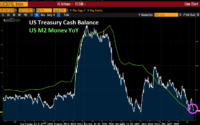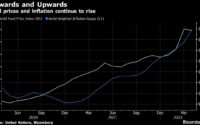What Comes After the Debt Ceiling?
Taps Coogan – May 26th, 2023
Enjoy The Sounding Line? Click here to subscribe for free.
As the latest installment of the debt ceiling drama inevitably inches towards resolution, it’s time to take stock of what happens next.
Back in March we noted that, at the time, $611 billion of the $613 billion balance sheet reduction that the Fed has accomplished via Quantitative Tightening (QT) had been offset by a drawdown of the Treasury General account during the same period, in large part due to the debt ceiling.
As it turns out, we wrote that article within a day or two of the Fed adding hundreds of billions of dollars back onto its balance sheet due to the SVB depositor bailout, undoing half of its QT program. While the Fed’s balance sheet has resumed a downward trajectory since then, the total today is still larger than in March. The Fed has only shrunk its balance sheet by about $529 billion as of the time of writing compared to $613 in March.
Meanwhile, the Treasury general account drawdown has continued thanks to the debt ceiling. That drawdown has reached roughly $883 billion since the Fed’s balance sheet peaked last April.
That means that general account drawdown has offset ~166% of all QT. All things being equal, 166% of the financial assets that private markets would have had to step in and absorb because of the Fed reducing its asset holdings have been offset by the Treasury drawing down its ‘savings’ instead of issuing new debt. In a round about way, that dynamic has created the equivalent of $354 billion net liquidity for financial markets. While not all of the reductions and add-backs in the Fed’s balance sheet since QT started represent treasuries, the liquidity is fungible.
When the debt ceiling gets raised in the coming days or weeks, the Treasury is going to need to issue hundreds of billions of dollars of new treasury debt and, for the first time since QT started, we’re going to see how the market reacts to a large amount of new supply without a corresponding offset somewhere else.
Most market participants are viewing a debt ceiling deal as bullish. While there may very well be a positive initial reaction, we expect a significant tightening of liquidity conditions in the coming months.
Would you like to be notified when we publish a new article on The Sounding Line? Click here to subscribe for free.

DISCLAIMER
[ad_2]
Source link


